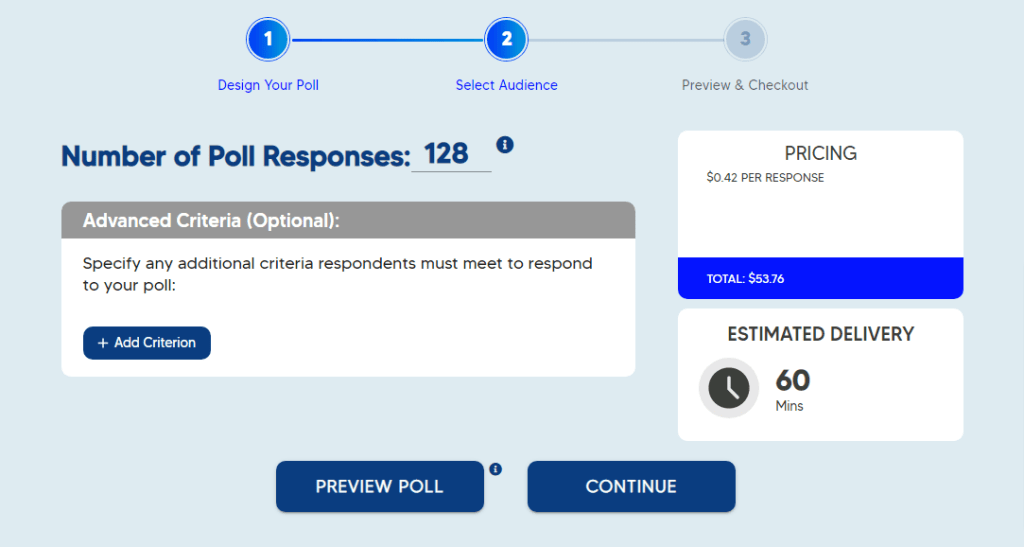
The chances of creating a successful business drastically increase when you make usability A/B testing a part of the process. That is if it is done without mistakes.
Before Poll the People was born we looked at many different testing methods, in-person, remote, unmoderated, and moderated testing, to make the best product.
We know a thing or two about running a usability A/B test and have made our fair share of mistakes. When these mistakes are made they always affect the results. If the results of the test aren’t accurate the business won’t match the user’s needs.
In this article, we’ll share some of the most common mistakes that you should be aware of and how to avoid them in your usability A/B test.
1. Not Setting Clear and Specific Goals
Usability A/B testing is a process that helps you understand user needs and identify the issues with your business. Each of your tests should aim to uncover what your users want and any issues they have with your website, app, or products.
It’s easy to just launch a test without doing research or creating a plan. But, this can be a huge mistake. If you don’t set clear and specific goals your results won’t solve any of your problems. You won’t know if the business matches the expectations and needs of the users.
How To Avoid This Mistake
Usability A/B testing should be a purposeful process that is clearly planned out. This plan needs to include specific goals to define what you want to get out of the test.
I suggest taking time before your test to plan out your goals and make them specific enough to know if the test was successful or not. The usability A/B test should confirm if there are problems with usability or if the user is satisfied with the business.
2. Not Asking The Right Questions
If you don’t ask users the right questions about their experiences you won’t know if your testing goals were met. The results will be insignificant and users might run into problems while doing the test.
The user will be interacting with your business without an objective without accomplishing anything valuable. Sometimes, you are asking questions that aren’t actionable or meaningful, causing many issues with your test.
For example, if the goal is to find issues with navigating your website the user should be asked how many clicks it took to get to a page or how hard it is to find a resource.
How To Avoid This Mistake
The questions you ask the users should be created from the goals you have. Before running a usability A/B test take time to figure out the parts of your business that might need fixing.
Also, think of how the questions should be written to clearly describe what needs to be done. The participants will follow your questions and test explanation so making them detailed and goal-oriented will produce the best results.
3. Testing Too Many Things At Once

While it may be tempting to test everything you think has issues that can confuse participants and create insignificant results. Each variation of a resource you add can break up the audience or could create multiple winners because they aren’t unique.
With usability A/B testing you compare two versions of your website, app, product, or service to understand what users like more. This allows your audience to make one decision at a time and give you valuable feedback.
How To Avoid This Mistake
The best practice in usability A/B testing is to create two versions of your resource and use them for the test. To avoid an increased margin of error and simplify things for testers and participants keep it to version A and version B.
If you need to test multiple designs, layouts, or variations, compare two to start and continue to test winning variations against the other options.
4. Targeting The Wrong Audience
 Imagine if you’re creating a social media app, but you’re testing with people that are in their 60s who have no interest. It isn’t hard to predict that the results won’t have any value. It creates a separation between the participants and the target audience.
Imagine if you’re creating a social media app, but you’re testing with people that are in their 60s who have no interest. It isn’t hard to predict that the results won’t have any value. It creates a separation between the participants and the target audience.
One of the most common mistakes is to use the wrong audience for a usability A/B test. It happens because the business doesn’t define the end-user. This leads to feedback that doesn’t solve problems or give the real target audience what they want.
How To Avoid This Mistake
Your team needs to define who the business is for and the people they want to target. Some great ways to do this are with user personas. Brainstorm the interests, age, hobbies, profession, and other characteristics that are. This paints a full picture of who you’re going after.
While choosing participants that aren’t your target is a problem, being too specific can also cause problems. You need to test with users that might be familiar with your product and some that aren’t. This creates more valuable results and ensures your products can be used by everyone.
5. Using Technical Language
A lot of times we assume the users know our business the same way we do. We spend so much time with the business and all of the details that it’s second nature to use technical jargon that most people don’t understand.
When you use a detailed explanation of your products the participants will struggle to understand what you are trying to tell them. If the participants don’t understand what you are asking or what they are using the feedback will suffer.
How To Avoid This Mistake
You need to think user first, you aren’t talking to a group of developers or coders but people who don’t know the details of your business. Use common words or synonyms for the technical details of your business. Ensure the responders know what you’re asking and understand instructions to get the most valuable results.
6. Conducting Only One Test
Another usability A/B testing mistake is only doing one test. Test in multiple phases to find the issues with usability and a final testing phase to see if the issues are fixed. If you conduct only one usability A/B test you’re risking the success of the business.
One test shouldn’t be the end all be all, it should show you what needs to be fixed and allow you to continue testing to optimize completely.
There is also always a degree of error in a single test, each one will give you different feedback. A single round of testing is never enough. You will overlook bugs and problems that will come up after launch.
How To Avoid This Mistake
To avoid this mistake you need to make a usability A/B testing plan and run a number of tests. At the very least do your testing in two phases, a prototype phase, and a final testing phase. Running two tests before going live will let you know if the usability issues you find are solved.
7. Testing To Confirm Your Ideas
We all fall victim to confirmation bias, we want our thoughts and opinions to be right. In usability A/B testing this can cause a lot of problems.
If you aren’t objective in a test and guide the users toward answering one way over another the test isn’t valuable. When you turn the test into a confirmation process you defeat the purpose.
How To Avoid This Mistake
Usability A/B testing isn’t about confirming your ideas, so be unbiased when testing, even if it means the version you like best isn’t the winner. It’s a lot easier said than done but start by accepting that you might be wrong.
Keep an open mind about the test, trust the data and feedback you gather to achieve your goals. Creating unbiased tests is a team effort when planning and analyzing results.
8. Using The Wrong Tool

Usability A/B testing is becoming a widely accepted way to optimize businesses, there are many players in the industry. But, not all tools are created equal and they all don’t offer the same benefits.
Some tools can make the creation process long or difficult, some might take days or weeks to give you results, others will be very expensive and not give you what you’re looking for. Usability testing with the wrong tools will waste time, money, and resources of your business.
How To Avoid This Mistake
Do some research on the different tools that are available and find the one that works best for your goals. Keep in mind your budget, the available time, and manpower you can commit to testing.
We have looked at a lot of different platforms and that’s why we created Poll the People. Our platform is a great tool for usability A/B testing and gives you great results. A typical test completes in about 60 minutes, not days or weeks. Our tests start at $1.00 per response, far less than the competitors and we offer many great resources that give you everything you need to successfully test your business.
Conclusion
Even with all of its benefits, usability A/B testing isn’t easy to do successfully. Chances are you have made one of these mistakes, I hope that the tips we explained are helpful for avoiding making the same mistakes we have.
Poll the People has more useful articles, pages, and info to help you run great usability A/B tests. If you’re new to testing and experience design take a look at the rest of our website and read up on benefits, challenges, use cases, and more for your business.
If you have the info you need to start optimizing right now, sign up and run a test. We have a great platform that lets you test everything from the colors or your logo to the usability of your whole website.
Good luck on your usability A/B testing journey, I hope you take that journey with us!
- How To Retain SEO Ranking After A Redesign - February 22, 2023
- Ultimate Guide: How to Write Brand Names - February 17, 2023
- 10 Best Practices for Using Video in Your Email Marketing Campaigns - February 8, 2023




